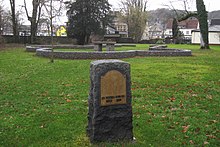Vitus Church (Hemer)
The Vitus Church was the oldest church building in Hemer , North Rhine-Westphalia and the oldest conical building in Westphalia. It was built in the 10th century and was a Protestant church from the Reformation in 1567. In 1818 the building was demolished because it was in disrepair .
history
The church was first mentioned in 1072 in a document from the Grafschaft monastery . The building was located in the immediate vicinity of the Hemer manor house and belonged to the Menden parish . The patron is not yet named at this time, but it is certain that St. Vitus was the namesake from the beginning. Exactly 50 years after it was first mentioned, the Archbishop of Cologne, Friedrich I von Schwarzenburg , elevated the parish of the Vitus Church to an independent parish in the Attendorn deanery . The close connection to the Grafschaft monastery, which provided the pastors in the following centuries, remained, however.
Presumably in the 2nd half of the 12th century, the church building was extended by three semicircular domed choir rooms on the east side and a low tower on the west side. The expansion of the choir resulted in the first three-icon arrangement in Westphalia. Around 1220 the church received a baptismal font.
In 1498 a ringing of three bells was hung in the tower, which remained in the church until the end.
In 1567 almost the entire Hemeraner community joined the Protestant church and continued to use the Vitus Church. The church building was enlarged again and again until it could hold around 200 believers. In 1753 efforts by the community began to get a larger structure. Some data on the size of the building also come from this period. The nave was 14 feet (5.04 meters) high and 48 feet (17.28 meters) long. At its widest point, the church was 36 feet (12.96 meters) wide.
Because the church was often exposed to floods, demolition was ordered in 1818. In the same year, construction began on the Ebberg Church a few hundred meters from the Vitus Church. Before the Protestant parish of Hemers could move into its new church building in 1820, they held their services in the neighboring Catholic parish church of St. Peter and Paul .
When the Vituskirche was demolished, the triple bell was still in the tower. The bells bore the dates 1498, 1750 and 1768. Of the three bells, the oldest and largest is still there, cast by Hillebrant Dubbe from Iserlohn . It hangs on the Paul Schneider House in the center of Hemer. The strike tone is f sharp '–6 (= deviations in 16th semitones). At the mouth, the bell has a diameter of 1055 mm and a weight of around 750 kg . The former baptismal font of the Vitus Church is still in the Ebberg Church today.
In 1954, the Hemer Citizens' Association and Homeland Association , later in collaboration with the State Monuments Office of Westphalia-Lippe , began excavating the foundations of the Vitus Church. Foundations and floors were partially exposed. One could determine different construction phases.
The excavations showed that the first church was about 14 meters long and a good seven meters wide. The chancel was in an apse to the east of the building. In the next construction phase, probably after the parish was raised, the apse made way for three conches . This increased the length of the church by a good three meters. In the west, a tower was probably added at the same time or a little later. During the next expansion, which has no time limit but was probably before 1767, rectangular extensions were added to the eastern side of the church. The excavation site was closed again after the work was completed. The construction of the church is considered unique in Westphalia.
On the occasion of the anniversary of the Reformation in 2017, the foundation walls from the 12th century with three-corner complex and west tower were made visible through low, stone-filled gabions, at the original location in the park of Haus Hemer. Four entrance doors should be indicated by recesses. The memorial stone previously located at the original location was moved to the east.
literature
- Friedrich Esterhues: On the excavation of the St. Vitus Church in: Citizens and Heimatverein Hemer (Hrsg.): Hemer. Contributions to local history. Engelbert-Verlag, Balve 1980.
- Friedrich Esterhues: Vitus Church oldest conical complex in Westphalia in: Citizens and local history association Hemer (ed.): The key. Hemer 1956.
- Werner Hoffmann: Former Vitus Church in The Fibel : Churches - Bells - Organs in the Hemer urban area. Volume 6, 2001, pp. 41-46, ISBN 3-89053-086-9 .
- Robert Gräve: Chronology of St. Vitus - Hemer's first church ( online version ) in: Bürger- und Heimatverein Hemer (Hrsg.): The key. Issue 4, 2017, volume 62, pp. 102–123.
- Robert Gräve: The Primer. Volume 11: Chronology of St. Vitus. Hemer's local and church history as reflected in the Vitus Church . Self-published by the Bürger- und Heimatverein Hemer eV, Hemer 2019. ISBN 978-3-00063301-0
Web links
Individual proof
- ^ Robert Gräve: Chronology of St. Vitus - Hemers first church . In: Bürger- und Heimatverein Hemer (Ed.) Der Schlüssel , 2017, Issue 4.
Coordinates: 51 ° 23 ′ 41.6 ″ N , 7 ° 45 ′ 41.4 ″ E


